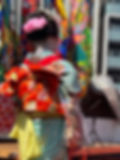


JAPAN: Art Exhibit, Studio Life &
Research
During our residency at Midori Art Center in Tokyo, we immersed ourselves in the city’s rhythm—splitting our time between the print studio, research, and preparing for the exhibition.
Alongside studio work, we explored Tokyo’s urban history and traveled to Kyoto, Naoshima, and Osaka for the World Expo and Triennale events, engaging with Japan’s vibrant contemporary and historical art scenes.

ART EXHIBIT

Kaveh, just five years old, proudly shows me the painting he made during his home class. Tempera strokes cover the page, every inch washed in deep black.
I smile and ask, “But Kaveh, where are the colours?”
He looks at me, eyes wide with certainty. “Don’t you see? The colours are inside.”
It was the middle of COVID19, and that reply stroke me as a revelation
Years later, while researching this project, I realized the phrase spoke to me on a deeply personal level—about resilience, resistance, and inner strength. Ultimately, it captured the essence of what I hoped this work would convey.
The body of work titled ‘The Colours are Inside’, is inspired by the Meiji-period kimonos—an era marked by Japan’s rapid Westernization and the resulting, often subtle, shifts in tradition. During this time, some formal kimonos featured subdued outer layers, while their intricate decorative elements were hidden on the inner lining or only in the garment’s right side lining, rendering them nearly invisible when worn.This discreet blending of cultural heritage with emerging influences functioned as a quiet act of resistance.
The exhibit features a series of works inspired by this concept. +INFO
STUDIO LIFE
At Midori, studio life unfolded as a vibrant “third space”—a place between work and home where creativity and collaboration thrived. We shared the studios at Bakuroyokoyama, meeting other artists, exchanging ideas, and observing diverse approaches to making. Afternoons often included coffee at the café downstairs, offering a casual setting to reflect, connect, and recharge. This rhythm of shared practice, conversation, and quiet observation created a dynamic environment that fueled experimentation, inspired new directions, and reinforced the sense of community at the heart of the residency.




URBAN RESEARCH
We walked Tokyo’s streets, studied old maps, and met with architects and designers to trace how the city’s layered history shapes its evolving identity. Site visits to projects such as KAIT Plaza, the Osaka World Expo, provided insight into how art and architecture intersect to create spaces of encounter and reflection.





At KAIT Plaza, we experienced a surreal pavilion by Junya Ishigami at the Kanagawa Institute of Technology, where sloping ground and a floating steel roof with no interior columns dissolve the boundaries between sky, earth, and built form. Rain filters through roof apertures, the floor undulates subtly, and shifting light transforms the space continuously, creating a fluid, immersive environment that challenges conventional perceptions of architecture and landscape.
At BONUS TRACK—a linear redevelopment of a former railway corridor in Shimokitazawa, often referred to as Tokyo’s “highline”—we experienced how adaptive reuse can foster community and intimacy within dense urban environments. These experiences deepened our understanding of the dialogue between tradition and innovation in Japanese urban design, informing our reflections on how cities everywhere can nurture connection, resilience, and cultural continuity through creative practice.



We investigated connections between Japanese and Latin American symbolism, focusing on nature as a metaphor for resilience and renewal. Working with both traditional and digital techniques, we deepened our understanding of how material experimentation can bridge intuition and structure, the personal and the collective.
At Naoshima and Teshima, we immersed ourselves in contemporary art that beautifully blends architecture, landscape, and sensory experience. On Naoshima, we wandered through installations that seemed to grow from the natural environment, while on Teshima, works like Les Archives du Cœur and the Teshima Art Museum offered quiet, contemplative moments. These experiences invited us to reflect on memory, presence, and our connection to the natural world, leaving a lasting mark on how we think and create.
BECOME PART OF THE CIRCLE
Get in touch at admin@sumoproject.com
